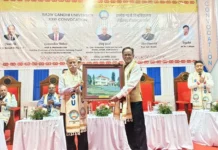Flights Of Fantasy
[ M Panging Pao ]
India has fought wars with China and Pakistan, and has frequent skirmishes and violent conflicts with both nations. Arunachal Pradesh is a frontline state and the only state in India to share borders with three countries. There are many lessons to be learnt from the ongoing Ukraine-Russia war.
Examples of strategically built infrastructure include the 660-km-long Indira Gandhi canal running through the states of Punjab, Haryana and Rajasthan. This canal is a major obstacle for enemy tanks and armoured vehicles.
The capital of Russia, Moscow, and the capital of Ukraine, Kyiv have multiple levels of underground metros which also double up as nuclear and air raid shelters. In case of any nuclear or air attack, the best shelter is underground. Metros built underground in Delhi, Kolkata, Bengaluru, etc, are also nuclear and air raid shelters.
Similarly, during the Cold War in the USA, no building plans were cleared without an underground shelter or cellar. These shelters and cellars were stocked with food and essential items to cater for nuclear wars.
Roads and railways built in border states are also strategically planned, catering for deployment of defence personnel and equipment. Construction of critical bridges across major rivers like the Brahmaputra, the Siang, the Subansiri, the Kameng and the Lohit has to cater for rapid deployment of defence personnel and equipment.
Critical bridges over major rivers like the Brahmaputra, the Siang, the Subansiri, the Lohit, the Kameng, etc, are also key targets for the enemy. Presently, most bridges are painted in bright colours, and can be easily targeted by aerial missiles. These bridges must be painted in camouflage colours to prevent easy detection and targeting.
Since the few bridges across the Brahmaputra can be easily targeted, strategic planning dictates that oil depots, ammunition dumps, etc, should be constructed on the northern bank of the Brahmaputra to support and sustain military operations in Arunachal Pradesh.
Potential targets for enemy include command and control centres, including national and state leaderships. Therefore, the central secretariats and head offices should also be painted in camouflage colours to merge with the background. A few underground shelters should also be built.
Another important aspect is to train selected common citizens in the basics of war fighting, including weapon firing, firing of anti-tank and anti-aircraft missiles, basic tactics, etc. Earlier, the erstwhile Special Services Bureau (SSB) used to undertake this role, which has been inexplicably stopped. Civil defence procedures like digging trenches near offices, air raid sirens and blackouts also need to be practiced in our towns and cities.
One more major aspect is to produce own weapons, aircraft, ships, tanks, missiles, etc. A good beginning has been made by policies like the Atmanirbhar Bharat and ‘vocal for local’ to indigenise and produce own weapons. This Atmanirbharta also applies to essential items like food, groceries, clothing, oil, medicines, etc.
For robust defence of the state and the nation, lessons must be learnt from the Ukraine war and strategic planning in all aspects is a necessity.
Isn’t it better to sweat in peace than to bleed in war? (The contributor is retired Group Captain, Indian Air Force)



